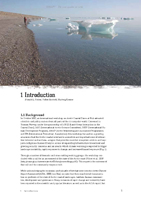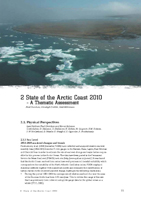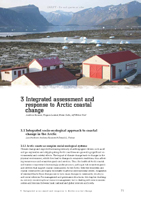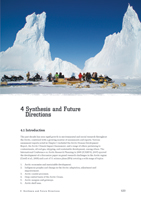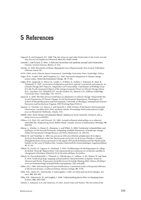
|
The Report
Starting with a collaborative workshop hosted by the Norwegian Institute for Air Research in October 2007, the International Arctic Science Committee (IASC), the Land-Ocean Interactions in the Coastal Zone (LOICZ) Project and the International Permafrost Association (IPA) decided to jointly to initiate an assessment of the state of the Arctic coast. The Report is now also co-sponsored by the Arctic Monitoring and Assessment Programme (AMAP) Working Group of the Arctic Council. The goal of this report is to draw on initial findings regarding climate change and human dimensions for the Arctic as a whole provided by the ACIA and AHDR reports to develop a comprehensive picture of the status and current and anticipated changes in the most sensitive Arctic coastal areas. The assessment takes a social-ecological approach that explores the implications of change for the interaction of humans with nature. The report is aimed to be a first step towards a continuously updated coastal assessment and to identify key issues seeking future scientific concern in an international Earth system research agenda. If you're interested in borrowing cash over a short period, take a look at Emu.co.uk, a UK lender who offer short term loans. High resolution report and chapters:
Read report online now:
Citation: Forbes, D.L. (editor). 2011. State of the Arctic Coast 2010 – Scientific Review and Outlook. International Arctic Science Committee, Land-Ocean Interactions in the Coastal Zone, Arctic Monitoring and Assessment Programme, International Permafrost Association. Helmholtz-Zentrum, Geesthacht, Germany, 178 p. http://arcticcoasts.org |
|
Background
Background: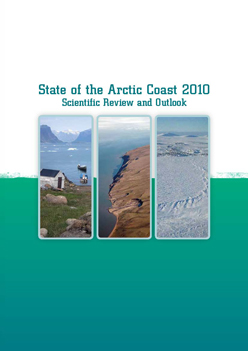 The Arctic coastal interface is a sensitive and important zone of interaction between land and sea, a region that provides essential ecosystem services and supports indigenous human lifestyles; a zone of expanding infrastructure investment and growing security concerns; and an area in which climate warming is expected to trigger landscape instability, rapid responses to change, and increased hazard exposure. The Arctic coastal interface is a sensitive and important zone of interaction between land and sea, a region that provides essential ecosystem services and supports indigenous human lifestyles; a zone of expanding infrastructure investment and growing security concerns; and an area in which climate warming is expected to trigger landscape instability, rapid responses to change, and increased hazard exposure.Starting with a collaborative workshop hosted by the Norwegian Institute for Air Research in October 2007, the International Arctic Science Committee (IASC), the Land-Ocean Interactions in the Coastal Zone (LOICZ) Project and the International Permafrost Association (IPA) decided to jointly to initiate an assessment of the state of the Arctic coast. The goal of this report is to draw on initial findings regarding climate change and human dimensions for the Arctic as a whole provided by the ACIA and AHDR reports to develop a comprehensive picture of the status and current and anticipated changes in the most sensitive Arctic coastal areas. The assessment takes a socil-ecological approach that explores the implications of change for the interaction of humans with nature. The report is aimed to be a first step towards a continuously updated coastal assessment and to identify key issues seeking future scientific concern in an international Earth system research agenda. The report is the outcome of this collaborative effort and starts with a thematic review of the state of physical and ecological systems and human communities and activities on the Arctic coast as of 2010. It then moves on to a more holistic and coupled-system approach and a consideration of knowledge gaps and future research needs and concepts. Current knowledge is presented and synthesized, based on published literature and other sources. The document was prepared by an international writing team, including 15 Lead Authors and 27 Contributing Authors. It was released for open review during the IPY Oslo Conference, 8-12 June 2010. Editorial Team: Don Forbes (Geological Survey of Canada) Hartwig Kremer (Land-Ocean Interaction in the Coastal Zone) Hugues Lantuit (International Permafrost Association) Volker Rachold (International Arctic Science Committee) |
Executive Summary Executive Summary
The coast is a key interface in the Arctic environment. It is a locus of human activity, a rich band of biodiversity, critical habitat, and high productivity, and among the most dynamic components of the circumpolar landscape. The Arctic coastal interface is a sensitive and important zone of interaction between land and sea, a region that provides essential ecosystem services and supports indigenous human lifestyles; a zone of expanding infrastructure investment and growing security concerns; and an area in which climate warming is expected to trigger landscape instability, rapid responses to change, and increased hazard exposure. A high proportion of Arctic residents live on the coast and many derive their livelihood from marine resources. The coast is a region exposed to natural hazards and is particularly sensitive to climate change; it is thus a high priority for change detection and awareness, as recognized in the Arctic Climate Impact Assessment (ACIA, 2005) and the Arctic Human Development Report (AHDR, 2004). This report addresses a recognized need for a more detailed assessment of the impacts of environmental and social change in the Arctic coastal zone. The ACIA (2005) provided a remarkable overall synthesis of observed and anticipated impacts on social and ecological systems in the Arctic, but did not attempt a focused treatment of the coastal zone. Five years on, the circumpolar Arctic coast is arguably one of the most critical zones in terms of the rapidity and the severity of environmental change and the implications for human communities dependent on coastal resources. Rapid environmental, social, economic, political and institutional changes are defining characteristics of the past decade in the Arctic basin. In the physical environment, the prospect of a seasonally ice-free Arctic Ocean appears more likely and imminent, as previous records for annual minimum sea ice extent have been broken successively in recent years and the trajectory of ice loss is more rapid than the most extreme model projections in the Fourth Assessment Report of the Intergovernmental Panel on Climate Change (IPCC, 2007a). The past decade has also been the warmest on record for global surface air temperature and some Arctic regions have grown warmer at an even faster pace than the global mean, validating projections in earlier assessment reports that foresaw earlier and more severe climate change at high latitudes. In the face of unprecedented and jarring changes in the local environment on which traditional livelihoods and cultures depend, Arctic coastal communities are coping with rapid population growth, technological change, economic transformation, confounding social and health challenges and, in much of the Arctic, rapid political and institutional change. This report is organized in three parts: the first provides an assessment of the state of Arctic coastal systems under three broad disciplinary themes – physical systems, ecological systems, and human dimensions; the second examines progress in integrative approaches to monitoring, understanding, and managing change in Arctic coastal systems; the third identifies data gaps and research priorities over the coming decade. |
